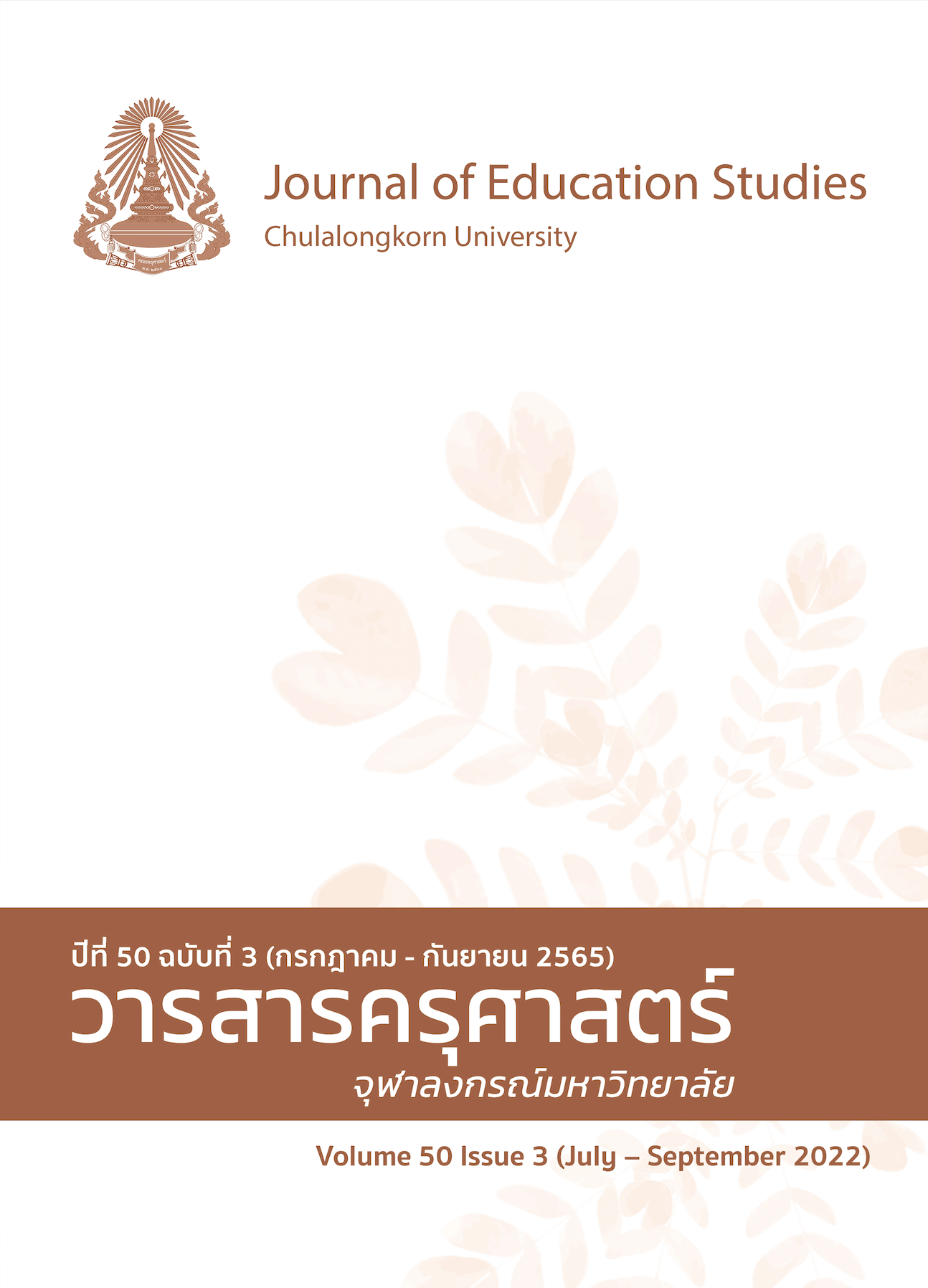A Confirmatory Factor Analysis of the Digital Culture for Extra-Large Schools Under the Secondary Educational Service Area Office of Buriram
DOI:
https://doi.org/10.14456/educu.2022.21Keywords:
factor analysis, digital culture, extra-large schoolsAbstract
The purposes of this research were: 1) to analyze the components of digital culture and 2) to analyze the levels of digital culture of extra-large schools under the secondary educational service area office of Buriram. A sample including 340 teachers and administrators from extra-large schools was drawn using stratified random sampling. The tool used for data collection was a 5-level rating scale questionnaire with content validity values between 0.60 and 1.00 and the reliability coefficient of 0.96. Descriptive statistics were percentage, mean, and standard deviation. Inferential statistics were tested by Bartlett’s Test of Sphericity and KMO test. And confirmatory factor analysis (CFA). The research found as follows: 1) Digital culture for extra-large schools under the secondary educational service area office of Buriram consisted of 6 main components, 17 subcomponents, namely (1) digital mindset comprising 3 subcomponents, (2)digital risk-taking comprising 3 subcomponents, (3) data driven comprising 2 subcomponents, (4) digital agility comprising 3 subcomponents, (5) collaborative value comprising 3 subcomponents, and (6) customer-centric comprising 3 subcomponents. 2) The model for measuring digital cultural components for extra-large schools under the secondary educational service area office of Buriram was congruent with the empirical data according to the statistical values of Chi square = 82.129, df = 63, P-Value = 0.0532, RMSEA = 0.030, SRMR = 0.021, CFI = 0.996, TLI = 0.991
References
ภาษาไทย
กรรณิการ์ อุตตะทอง. (2561). การวางแผนการปฏิบัติงานในองค์การยุค 4.0. Journal of Modern Learning Development, 3(2), 41-51.
กระทรวงดิจิทัลเพื่อเศรษฐกิจและสังคม. (2562). รายงานประจำปี 2562 กระทรวงดิจิทัลเพื่อเศรษฐกิจและสังคม.
http://digital.nlt.go.th/items/show/17254
กระทรวงศึกษาธิการ. (2563). การป้องกันและควบคุมสถานการณ์แพร่ระบาดของโรคติดเชื้อไวรัสโคโรนา 2019.
http://www.reo9.obec.in.th/gis/eoffice/10000002tbl_orgdownload/20200305163032PIX9lw8.pdf
เกรียงศักดิ์ เจริญวงศ์ศักดิ์. (2562, 18 พฤศจิกายน). เงื่อนไขความสำเร็จของการเปลี่ยนผ่านสู่ดิจิทัล (digital transformation). CIO world &
business. http://www.cioworldmagazine.com/dr-kriengsakchareonwongsak-key-success-digital-transformation
เกสรา ศักดิ์มณีวงศา. (2561, 8 มีนาคม). เตรียมความพร้อมให้องค์การยุคดิจิตอล. กรุงเทพธุรกิจ.
http://www.bangkokbiznews.com/blog/detail/644094
ธนชาติ นุ่มนนท์ (2562, 22 มีนาคม). กลยุทธ์สู่ความสำเร็จด้าน ‘ดิจิทัล ทรานส์ฟอร์เมชั่น. กรุงเทพธุรกิจ.
https://www.bangkokbiznews.com/blog/detail/646871
ประกฤติยา ทักษิโณ. (2559). การวิเคราะห์ข้อมูลด้วย LISREL และ MPLUS: ความรู้พื้นฐานก่อนการวิเคราะห์. มหาวิทยาลัยขอนแก่น.
แผนพัฒนารัฐบาลดิจิทัลของประเทศไทย พ.ศ 2563-2565. (2564, 14 มิถุนายน). ราชกิจจานุเบกษา. เล่ม 138 ตอนพิเศษ 127 ง. หน้า 32.
ไพฑูรย์ สินลารัตน์ และ นักรบ หมี้แสน. (2560). ความเป็นครูและการพัฒนาครูมืออาชีพ. สำนักพิมพ์แห่งจุฬาลงกรณ์มหาวิทยาลัย.
เศรษฐพงค์ มะลิสุวรรณ. (2560). The year of disruption. http://tct.or.th/images/article/special_article/
/198410_disruption.pdf
สงบ อินทรมณี. (2562). การบริหารสถานศึกษาในยุคดิจิทัล. วารสารวิชาการมหาวิทยาลัยการจัดการและเทคโนโลยีอีสเทิร์น,
(1), 353-360.
สำนักงานเขตพื้นที่การศึกษามัธยมศึกษาบุรีรัมย์. (2564). ข้อมูลสารสนเทศด้านการศึกษา สพม.บุรีรัมย์.
https://sites.google.com/ssbr.go.th/ssbr/
สุวิมล ติรกานันท์. (2555). การวิเคราะห์ตัวแปรพหุในงานวิจัยทางสังคมศาสตร์ (พิมพ์ครั้งที่ 2). โรงพิมพ์แห่งจุฬาลงกรณ์มหาวิทยาลัย.
สุปราณี วรรณรุณ และ ธเนศ ปทุมานนท์. (2563). ปัจจัยที่มีความสัมพันธ์กับรูปแบบการพัฒนาองค์กรในยุคดิจิทัล.
วารสารวิชาการศรีปทุม ชลบุรี, 17(2), 43-54.
ภาษาอังกฤษ
Anand, A., Kaur, K., Narula, N., & Vasquez-McCall, B. (2021). Why an agile transformation office is your ticket to real and
lasting impact. https://shorturl.asia/L98HC
Azzouzi, M. (2018, October 9). Digital transformation through HR & employee experience. HEX Organization.
Gere, C. (2008). Digital culture (2nd ed.). Reaktion Books.
Hair, J. F., Anderson, R. E., Tatham, R. L., & Black, W. C. (1998). Multivariate data analysis (5th ed.).
Prentice hall college div.
Henley, M. (2019, May 3). 3 Steps to building a digital culture.
https://www.cmswire.com/digital-workplace/3-steps-to-building-a-digital-culture/
Kaplan, J. (2015, June 1). Learning from Google’s digital culture. https://shorturl.asia/Gwe5f
Kamath, S. (2019, January 23). What is digital mindset and why is it important?. Knolskape.
https://knolskape.com/blog-what-is-a-digital-mindset-and-why-is-it-important/
Krach, K. (2017, Jan 13). 5 Ways millennials guide the digital culture. https://medium.com/@keithkrach/5-ways-
millennials-guide-the-digital-culture-d7b80a7f8283
Kumar, A. N., & Bhushan, S. (2020). Digital culture – evolving context, enduring concepts and everlasting solutions.
Journal of services research, 20(1), 39-56. https://eds.s.ebscohost.com/eds/pdfviewer/pdfviewer?vid=2&sid=70fdcf34-
cca-49a8-8989-ac16181aecfc%40redis
Microsoft. (2019). Digital culture: Your competitive advantage. (n.p.).
Morakanyane, R., Grace, A., & O'Reilly, P. (2017). Conceptualizing digital transformation in business organizations: A
systematic review of literature. From connecting things to transforming our lives. 30th bled eConference digital
transformation. 1-14. https://doi.org/10.18690/978-961-286-043-1.30.
Piscione, D. P. (2014). The risk factor: why every organization needs big bets, bold characters, and the occasional
spectacular failure. St. Martin's.
Ridwandono, D., & Subriadi, A. P. (2019). IT and organizational agility: A critical literature review. Procedia Computer
Science, 1(1), 151-159.
Samuelson, J. (2016, February 1). The digital revolution – from idea to consumer experience with Electrolux.
Udapudi, A. (2019, May 8). What is digital culture and why it should matter to you. https://shorturl.asia/0J8sf
Vliet, M. V. (2018, May 30). The importance of a digital culture. Linkedin. https://www.linkedin.com/pulse/importance-
digital-culture-michiel-van-vliet
World Economic Forum. (2021). Digital culture: the driving force of digital transformation. (n.p.).
Downloads
Published
How to Cite
Issue
Section
License

This work is licensed under a Creative Commons Attribution-NonCommercial-NoDerivatives 4.0 International License.




